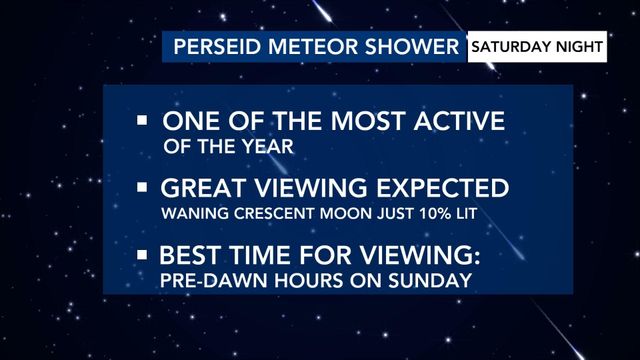You can watch the Perseid meteor shower at its peak Saturday night at Dix Park
The Perseid meteor shower will reach its peak Saturday and into the early morning hours of Sunday. Mostly clear skies are forecasted with clouds expected to continue decreasing throughout the night.
All you need to do to watch the shower is set up a chair in an open area and look up at the sky.
There is also going to be a watch party Saturday night at the Big Field at Dix Park from 9 p.m. to 11 p.m.
Staff and volunteers from the Morehead Planetarium & Science Center and Raleigh Astronomy Club will be at the watch party. They'll have telescopes so you can get a closeup look at the meteors, double stars, star clusters, nebulae and galaxies.
Even the most active showers like the Perseids vary from year to year, but 2023 looks to be particularly good because the Moon stays below the horizon until nearly 3 a.m. Even during those hours before sunrise, when the most meteors are usually seen, only 10% of the waning crescent moon will be reflecting sunlight.
More meteors are visible during the hours before sunrise because this is when the Earth is turning into the stream of dust and debris that produce the meteors. For the Perseids, that was Comet Swift–Tuttle, which last passed through our neighborhood in 1992.
The radiant, or point in the sky where the meteors appear to be coming from, is also highest in the sky after midnight, which means fewer meteors are hidden below the horizon.
But the hours after sunset, beginning around 10 p.m. can be pretty good as well. This is when "earth-grazers" are most visible. Thess are meteors which are hitting the top of the atmosphere at a very sharp angle, producing very bright, very persistent trails which can last several seconds.

Meteor watching tips
- The darker the skies, the more meteors you will see. If you can't make it to a rural location, look to the darkest part of the sky you are under. Meteors can appear anywhere.
- Take your time and enjoy the night sky. The more time you spend outside looking up, the more meteors you will see. Sometimes several meteors may be visible at once, sometimes they are more spread out. Give your eyes about 15 minutes to adjust to the darkness, you'll be amazed at how much more you will see.
- Leave your phone inside. Every time you look at a light, that 15 minute timer starts over.
Join the Morehead Planetarium at the Dorothea Dix Park Big Field Saturday Night from 9 p.m. to 11 p.m for skywatching. All ages are welcome and the Raleigh Astronomy Club will be sharing their telescopes to view other celestial delights, like as double stars, star clusters, nebulae, and galaxies.











